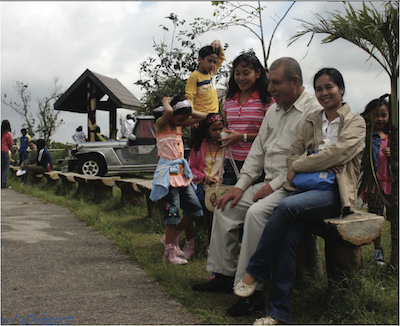Future Now
The IFTF Blog
Looking Backwards from 2025
An Anthropologist Explores How Body Area Networks Became Family Area Networks
Today, in 2025, we take it for granted that the networks of smart objects in, on, and around our bodies keep us connected. The new body-wellness information they generate allows us to care for one another deeply and effectively, in ways never imagined before. And it seems like the more data on our everyday behaviors we share, the more we discover new ways of expressing our love to our families, no matter where they are or how we define kinship.
But this, of course, wasn’t always the case. Renowned anthropologist Jan English-Lueck was there in the early days, tracking this emerging way of keeping the family together. Future Now sat down with Dr. English-Lueck to learn about what these practices looked like as early as 2015 and how we got to where we are today.
How has body area network tech changed how we care for our families?

A decade ago, people were shifting toward urban areas, often away from extended families, creating ever more isolated nuclear families. Yet we imagined that family members would still manage loved ones’ finances, education, and health care. Even with computers and smart phones families found it hard to connect.
Now in 2025, with big data, widespread environmental sensing, and a global focus on wellness, self-tracking is a lot easier. Monitoring, health tracking, and coaching enable people to act on family connections at a distance. Family members are coming to understand each other at the microbial, genomic, dietary, and mood level. Fictive kin (as in, the families we choose), pets, and geographically distant relatives can all read our tness tracker feeds.
It didn’t take long to go from laborious food tracking to ubiquitous sensor-based information on what we eat. Workplaces and municipal planners reshaped our environments, encouraging behaviors that promote wellness. All this happened in the highly visible epicenter of big data mining.
Can you give an example of mobilizing these technologies to connect family caregivers?
Increasingly, the isolation of aging populations across Asia has led to new networks of remotely connected, adopted families, who take care of each other through connective technologies. We know from studies of Japan that “embodied empathy” is a core cultural value. Remotely connecting the elderly began to get really sophisticated in about 2020, driven by their need to connect to each other and to younger generations, even to fictive kin, including “adopted” grandchildren.

In China, family area networks further the kinds of behaviors their society wants to encourage, such as sharing. In a country where the one-child policy means most kids don’t have siblings, people worried that children from singleton families would grow up self-absorbed, without a moral compass guiding them toward family. Schools focused on connecting to families and soon moved from mobile phone conversations to much more wraparound tracking and continuous communication. A behavior such as sharing can be monitored and assessed like other educational outcomes. That kind of monitoring mirrored others done in health care.
Today, closer monitoring of pregnant mothers gives family members a way to help support the mom—and also opens her up to increased scrutiny. Chinese medicine has a long tradition of taking care of pregnant women through medicinal food, but there was a profound gap between that practice and what “modern” mothers were expected to do to produce the best quality baby. In 2015 this often meant vitamins, supplements, and folic acid.
It also meant paying attention to the food chain. Farmer’s markets were viewed with suspicion as unmonitored and unscientific. In the last decade, the need to support pregnant women has translated into some robust monitoring and communication among diverse practitioners and family members. The distrust of the food chain—and the need to monitor water pollution and soil fertility—has created a market for trusted food. That information feeds more directly into pregnant women’s body area feeds, also informing family members. Mom knows what you’re eating.
In 2018, you spoke about how hidden knowledge about our genetics, transplantation, and surrogacy was making us rethink what family means. How does information about our secret selves shape today’s families?
All kinds of information, from our genetic markers to our parents’ reproductive histories, is no longer hidden. This transparency enables new family relationships and connections. When babies have multiple mothers and fathers through donation and surrogacy, new rules of kinship emerge.
Beyond the people you know about, your family extends to this much larger community of people connected at an intimate molecular level. This makes connections much more thorough and complex than they once were. We learned about our DNA relatives’ health vulnerabilities, and then we learned to care about them, and then for them. Just as families linked by transplanted organs began to care for each other, these relatives formed communities of care, which is something you see a lot of today. Using body area networks, we connect continuously to help each other emotionally and logistically, often with deliberate health monitoring and intervention. Welcome to networked families.
[photo credit: Flickr user Dodong Flores]
 FUTURE NOW—The Complete New Body Language Research Collection
FUTURE NOW—The Complete New Body Language Research Collection
The New Body Language research is collected in its entirety in our inaugural issue of Future Now, IFTF’s new print magazine.
Most pieces in this issue focus on the human side of Human+Machine Symbiosis—how body area networks will augment the intentions and expressions that play out in our everyday lives. Some pieces illuminate the subtle, even invisible technologies that broker our outrageous level of connection—the machines that feed off our passively generated data and varying motivations. Together, they create a portrait of how and why we’ll express ourselves with this new body language in the next decade.
For More Information
For more information on the Tech Futures Lab and our research, contact:
Sean Ness | sness@iftf.org | 650.233.9517



